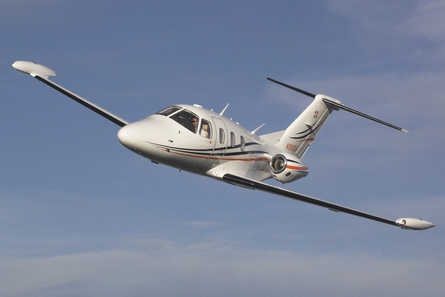Identification of a potentially serious flaw in the throttle quadrant of Eclipse 500 very light jets, after a near landing accident, has dealt a further setback to the embattled programme.
US Federal Aviation Administration regulators have ordered pilots to carry out a test of the type's throttle after an Eclipse 500's engines stuck at maximum thrust during a critical phase of landing at Chicago Midway on 6 June.
After pushing the throttles to maximum, in a bid to overcome a sudden windshear-induced sink on approach, the pilot could not reduce the thrust as the jet touched down. The aircraft was forced to take off again.
 |
|---|
© Eclipse Aviation |
With the thrust levers at idle, but the jet unresponsive, the pilot attempted to reduce airspeed by deploying undercarriage and flaps, and maintained a positive angle of attack to stay below 200kt (370km/h).
Investigators traced the cause to a failure of both dual-channel throttle controls that electronically link the thrust levers to the full-authority digital engine controls in the Eclipse 500's Pratt & Whitney Canada PW610Fs.
When the thrust levers were pushed fully forward against the maximum-power stops, during tests, the crew-alerting system warned of left and right engine-control failure.
In the Chicago incident the FADEC software correctly maintained the last valid thrust setting, so the engines stayed at full power. To try to regain control the pilot shut the right engine down.
This cleared the original engine-control failure in that powerplant but, because of the Eclipse's cross-linked FADEC, the left engine automatically reduced thrust to the idle setting of the healthy - but shut off - right engine.
Despite a lack of formal procedures to deal with the emergency, the pilot managed to manoeuvre the jet to a safe landing. None of the four on board was injured.
US National Transportation Safety Board investigators have yet to determine the precise cause of the failure, but point out that the jet had only accumulated 238 flight hours since new.
"The board is concerned about the reliability of an assembly that fails in such a short time," it says, adding that similar instant failure of a replacement part "suggests there may be a design or quality problem".
Eclipse Aviation has since developed an appropriate emergency procedure and sent it to customers. The company stresses that the type has not been grounded and says the FAA directive amounts to a 10min test by the pilot, adding: "This is the only instance in which we've seen this problem in 25,000 hours of flight."
The throttle issue follows a series of setbacks for Eclipse. Earlier this year the Albuquerque-based airframer sealed a financial rescue package with its distributor, European Technology and Investment Research Centre, involving an equity investment described as "substantially in excess of $100 million" that gave Etirc founder Roel Pieper a 51% stake and made him non-executive chairman.
More recently, key customer DayJet, the Florida air taxi operator, has cut back operations, laying off 100 workers and looking to sell or lease half its fleet of 28 Eclipse 500s. Plans to take delivery of four aircraft a month through the year are on hold, and Eclipse is supplying those aircraft to other customers.
The European Aviation Safety Agency has yet to certificate the Eclipse 500 and have highlighted a number of specific concerns.
Source: Flight International



















